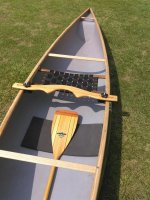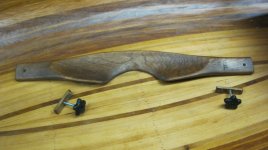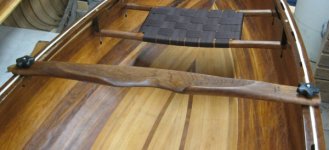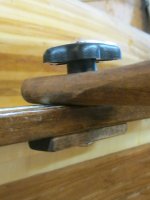A warning. A portage yoke design similar to Jim's above, put too much stress on my Bell Magic's gunwales. All of the stress is focused on the forward fasteners. I like the design, but suggest strengthening the gunwale at this point.
-
Happy National Letter Writing Day! 📝✉️📬
You are using an out of date browser. It may not display this or other websites correctly.
You should upgrade or use an alternative browser.
You should upgrade or use an alternative browser.
DIY solo portage yoke ideas?
- Thread starter jish1969
- Start date
A warning. A portage yoke design similar to Jim's above, put too much stress on my Bell Magic's gunwales. All of the stress is focused on the forward fasteners. I like the design, but suggest strengthening the gunwale at this point.
Good warning Mike !
I haven't seen that yoke for the Magic.
Half of the stress, with this criss cross strap idea, is fore and aft, not port and starboard. So it should reduce the pulling inward of the gunnels. Plus my inwhales are glued and screwed.
Jim
Hi Jim,
I think you may find using polyester webbing instead of nylon will be a better choice for this application. Less stretch, better strength, UV resistant and won't absorb water.
The actual location of your straps looks near perfect, as they sit between two lateral supports (seat and forward thwart) .... that should fully support the gunnels at the attachment points, plus we are talking a solo canoe weight which hopefully is in the 40 pound range, so almost anything you do will most likely be over engineered for purpose.
My next project is attempting a new tarp for my Tentsile Flyte, not liking the supplied one much and feel I can do better ... that means learning to sew (a bit). The research for that is done, I have the material and am in the planning/execution phase ... I only mention this, because having an idea of what sewing can accomplish has influenced my views a bit on how to customize any projects that use material/strapping stuff.
I really like this concept and intend to a) follow this b) look at it as a option for my next solo (hopefully later this summer) ... so you asked for thoughts .....
- as above, use polyester webbing for minimum stretch
- you could adjust the shape of the V by moving the cross over point manually to form a wider/shallower V to customize to the user (lock the cross over with stitching/rivet etc.)
- wider webbing would be more comfy
- you could actually still use a stiff foam pad on the shoulder strap area .. that could be sewn in or just sliding (likely require some material covering)
- if the V angle is too severe, maybe add a gusset (silpoly or maybe wider webbing) in the crotch to better fit around the neck area
- if you get really ambitious, a set of formed pads might work really well .... I am thinking something like curved composite, with thin foam, shaped to fit and hug the users shoulder .... lock pads in place or not, depending on whether you want to be able adjust balance on the go
I love ideas like this that make you think a bit.
Brian
I think you may find using polyester webbing instead of nylon will be a better choice for this application. Less stretch, better strength, UV resistant and won't absorb water.
The actual location of your straps looks near perfect, as they sit between two lateral supports (seat and forward thwart) .... that should fully support the gunnels at the attachment points, plus we are talking a solo canoe weight which hopefully is in the 40 pound range, so almost anything you do will most likely be over engineered for purpose.
My next project is attempting a new tarp for my Tentsile Flyte, not liking the supplied one much and feel I can do better ... that means learning to sew (a bit). The research for that is done, I have the material and am in the planning/execution phase ... I only mention this, because having an idea of what sewing can accomplish has influenced my views a bit on how to customize any projects that use material/strapping stuff.
I really like this concept and intend to a) follow this b) look at it as a option for my next solo (hopefully later this summer) ... so you asked for thoughts .....
- as above, use polyester webbing for minimum stretch
- you could adjust the shape of the V by moving the cross over point manually to form a wider/shallower V to customize to the user (lock the cross over with stitching/rivet etc.)
- wider webbing would be more comfy
- you could actually still use a stiff foam pad on the shoulder strap area .. that could be sewn in or just sliding (likely require some material covering)
- if the V angle is too severe, maybe add a gusset (silpoly or maybe wider webbing) in the crotch to better fit around the neck area
- if you get really ambitious, a set of formed pads might work really well .... I am thinking something like curved composite, with thin foam, shaped to fit and hug the users shoulder .... lock pads in place or not, depending on whether you want to be able adjust balance on the go
I love ideas like this that make you think a bit.
Brian
G
Guest
Guest
I love ideas like this that make you think a bit.
Me too. We have some folks with serious thinking caps here.
- Joined
- Jun 30, 2014
- Messages
- 1,550
- Reaction score
- 286
The gate hinge idea is pretty slick too. Probably a better option for longer carries. What about a wooden T that you put through the scupper inverted and then have a bolt mounted in the "I" part for a yoke to screw down onto. This would eliminate the problem of it slipping on the gunwale as the scupper would capture it. No extra holes drilled in the inwales that way.
Or it could be " U" shaped with two bolts and go on either side of a scupper.
Ideas ideas ideas.
Christy
Or it could be " U" shaped with two bolts and go on either side of a scupper.
Ideas ideas ideas.
Christy
I really like that gate hinge. Very clever.
What about a friction fit for the gunwales instead of fasteners? A similar idea to those foam blocks for mounting on vehicle rooftops? Dense foam cut to approximate gunwale profile, fastened on yoke ends? And the yoke needn't be fancy, maybe large pad blocks on an old thwart?
What about a friction fit for the gunwales instead of fasteners? A similar idea to those foam blocks for mounting on vehicle rooftops? Dense foam cut to approximate gunwale profile, fastened on yoke ends? And the yoke needn't be fancy, maybe large pad blocks on an old thwart?
G
Guest
Guest
Now I have a yoke question. Specifically about clamp-on style yokes and transport.
I never trusted those L brackets and screw knob thingies to hold a removable yoke in place during transport. I glued some thin sheet rubber (and on another, scrap neoprene) to the part of the L that tightens against the inwale as anti-slip & slide precaution, but I still didn’t trust that the clamp-on yoke would be there when I arrived. If anything is rattling threads loose it is miles of washboard dirt road.
But I kinda needed it to get the boat and off the roof racks. So when solo I would rack the canoe and then remove the yoke for travel. With short roof racks there wasn’t a lot of room to work between the roof and gunwales, and the taller Quick and Easy’s are on the van, so that was another step ladder job.
Putting the yoke back on at a launch was even more of a PITA; upside down, bassakwards, in a tight space or on a ladder. I didn’t bother most times and just manhandled the boat off the racks. Err, sometimes it bounced when it hit the ground.
That may be a demerit for simple L-bracket removable yokes. I had a DIY job on an early rebuild that attached with knobs that screwed into a threaded fitting countersunk in the inwale, and had more confidence in that.
That threaded fitting might be a solution for someone tricky who makes their own wood gunwales. I recall that someone here shapes little bump-outs on wood inwales for outfitting purposes.
Well hell, another question or two:
What are those knobs with bolt threads called?
And what are those little flanged & threaded sleeve thingees?
I never trusted those L brackets and screw knob thingies to hold a removable yoke in place during transport. I glued some thin sheet rubber (and on another, scrap neoprene) to the part of the L that tightens against the inwale as anti-slip & slide precaution, but I still didn’t trust that the clamp-on yoke would be there when I arrived. If anything is rattling threads loose it is miles of washboard dirt road.
But I kinda needed it to get the boat and off the roof racks. So when solo I would rack the canoe and then remove the yoke for travel. With short roof racks there wasn’t a lot of room to work between the roof and gunwales, and the taller Quick and Easy’s are on the van, so that was another step ladder job.
Putting the yoke back on at a launch was even more of a PITA; upside down, bassakwards, in a tight space or on a ladder. I didn’t bother most times and just manhandled the boat off the racks. Err, sometimes it bounced when it hit the ground.
That may be a demerit for simple L-bracket removable yokes. I had a DIY job on an early rebuild that attached with knobs that screwed into a threaded fitting countersunk in the inwale, and had more confidence in that.
That threaded fitting might be a solution for someone tricky who makes their own wood gunwales. I recall that someone here shapes little bump-outs on wood inwales for outfitting purposes.
Well hell, another question or two:
What are those knobs with bolt threads called?
And what are those little flanged & threaded sleeve thingees?
Those might be called "knobs"
https://www.mcmaster.com/#machine-component-knobs/=17s1366
not sure about the flanged and threaded thingies...
Do you mean captive nuts (PEM nuts?)
https://www.mcmaster.com/#captive-nuts/=17s13t9
Or do you mean threaded inserts for wood?
https://www.mcmaster.com/#=17s14r3
https://www.mcmaster.com/#machine-component-knobs/=17s1366
not sure about the flanged and threaded thingies...
Do you mean captive nuts (PEM nuts?)
https://www.mcmaster.com/#captive-nuts/=17s13t9
Or do you mean threaded inserts for wood?
https://www.mcmaster.com/#=17s14r3
G
Guest
Guest
"Knobs" eh? Whoda thunk it.
Trust McMaster Carr to have every imaginable type of knob.
On my first boat, I used the threaded inserts, to hide the hardware .... that technique is described here:
http://www.greenval.com/FAQhidden.html
Once you get to a site with the hardware, you will find that you can also use them as plain insert in wood, allowing you to just thread a bolt/rod/knob into it. I set mine in epoxy and they don't let go, I installed my first seat using the helicoils' and it's solid. If you use the locking type coils, they don't loosen.
As far as knobs go ... I was planning on using these with the coils on my next build:
http://www.leevalley.com/en/hardware/page.aspx?p=61655&cat=3,43576,61994&ap=1
LV has a lot of other ones as well, you need to explore a bit to see if there is something that fits your needs.
Brian
http://www.greenval.com/FAQhidden.html
Once you get to a site with the hardware, you will find that you can also use them as plain insert in wood, allowing you to just thread a bolt/rod/knob into it. I set mine in epoxy and they don't let go, I installed my first seat using the helicoils' and it's solid. If you use the locking type coils, they don't loosen.
As far as knobs go ... I was planning on using these with the coils on my next build:
http://www.leevalley.com/en/hardware/page.aspx?p=61655&cat=3,43576,61994&ap=1
LV has a lot of other ones as well, you need to explore a bit to see if there is something that fits your needs.
Brian
No Title
Well I may have cheated a bit on the diy in the end. When we were in Saranac last weekend I stopped at St Regis Canoe Outfitters and they had yoke hardware for only $18.95 so I sprung on it. Since I already had an old Mad River yoke I just took the jigsaw and some teak oil to it and it works great.
Well I may have cheated a bit on the diy in the end. When we were in Saranac last weekend I stopped at St Regis Canoe Outfitters and they had yoke hardware for only $18.95 so I sprung on it. Since I already had an old Mad River yoke I just took the jigsaw and some teak oil to it and it works great.
Attachments
Here is a link I found when looking up yoke ideas.
http://www.paddlinglight.com/product/solo-canoe-yoke-plans-portaging/. Similar to the yoke/ backrest minus the backrest. Seems a simple solution
http://www.paddlinglight.com/product/solo-canoe-yoke-plans-portaging/. Similar to the yoke/ backrest minus the backrest. Seems a simple solution
No Title
What I did on my Jacks, which wasn't supposed to be a tripping boat... back in May when we took it on it's first trip we found the clamp on Teal yoke that we use on other boats tended to slip on one side no matter how tight we cranked the knobs, so, I had to find another way. I pondered it awhile and finally decided to do version 2.0 of what Mem does. He tends to use the KISS method and although I had decided to go wingnutty, I took it to a place I would be less likely to lose a wingnut. I stripped the knobs from the other Teal and set about setting up the new Teal contour yoke I purchased for this boat.
The inwales on the Jacks are thinner than we usually do and D Fir, so I wanted some lateral support rather than just the bolt point, which was achieved with some strips of Maple. The carriage bolts sink into that a bit but I will likely epoxy them in next time I have some made up.
We had the boat out in the yard on a horse and kept moving it until it balanced itself then marked those points to ensure once I drilled the holes it would be in the correct place or as close as possible.
So this is what I got. I still need to throw a couple coats of varnish on the bits but I think it will be strong and ideal for what I need, also gets the boat a little higher on my shoulders to allow me to see better.
What I did on my Jacks, which wasn't supposed to be a tripping boat... back in May when we took it on it's first trip we found the clamp on Teal yoke that we use on other boats tended to slip on one side no matter how tight we cranked the knobs, so, I had to find another way. I pondered it awhile and finally decided to do version 2.0 of what Mem does. He tends to use the KISS method and although I had decided to go wingnutty, I took it to a place I would be less likely to lose a wingnut. I stripped the knobs from the other Teal and set about setting up the new Teal contour yoke I purchased for this boat.
The inwales on the Jacks are thinner than we usually do and D Fir, so I wanted some lateral support rather than just the bolt point, which was achieved with some strips of Maple. The carriage bolts sink into that a bit but I will likely epoxy them in next time I have some made up.
We had the boat out in the yard on a horse and kept moving it until it balanced itself then marked those points to ensure once I drilled the holes it would be in the correct place or as close as possible.
So this is what I got. I still need to throw a couple coats of varnish on the bits but I think it will be strong and ideal for what I need, also gets the boat a little higher on my shoulders to allow me to see better.
Attachments
Similar threads
- Replies
- 33
- Views
- 3K
- Replies
- 6
- Views
- 659
- Replies
- 46
- Views
- 5K
- Replies
- 23
- Views
- 1K




